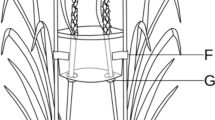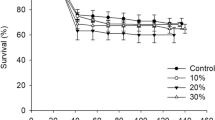Abstract
We investigated the role of olfactory cues from actively fermenting yeast (Saccharomyces cerevisiae) in attraction of adult Philornis downsi and identified two synergistically attractive yeast volatiles. Larvae of this invasive fly parasitize the hatchlings of passerines and threaten the Galapagos avifauna. Gas chromatography coupled with electroantennographic detection (GC-EAD), coupled gas chromatography-mass spectrometry (GC-MS), and field trapping experiments were used to identify volatile compounds from a yeast-sugar solution. EAD responses were consistently elicited by 14 yeast volatiles. In a series of field trapping experiments, a mixture of the 14 EAD-active compounds was similarly attractive to P. downsi when compared to the yeast-sugar solution, and we found that acetic acid and ethanol were essential for attraction. A mixture of 0.03 % acetic acid and 3 % ethanol was as attractive as the 14-component blend, but was not as attractive as the yeast-sugar solution. Philornis downsi showed positive and negative dose-responses to acetic acid in the ranges of 0.01 ~ 0.3 % and 0.3 ~ 9 %, respectively. Further optimization showed that the mixture of 1 % acetic acid and 3 % ethanol was as attractive as the yeast-sugar solution. Both mixtures of acetic acid and ethanol were more selective than the yeast-sugar solution in terms of non-target moths and Polistes versicolor wasps captured. These results indicate that acetic acid and ethanol produced by yeasts are crucial for P. downsi attraction to fermented materials on which they feed as adults and can be used to manage this invasive fly in Galapagos.






Similar content being viewed by others
References
Ai M, Min S, Grosjean Y, Leblanc C, Bell R, Benton R, Suh GS (2010) Acid sensing by the Drosophila olfactory system. Nature 468:691–695
Banat IM, Nigam P, Singh D, Marchant R, McHale AP (1998) Review: ethanol production at elevated temperatures and alcohol concentrations: part 1 – yeasts in general. World J Microbiol Biotechnol 14:809–821
Becher PG, Flick G, Rozpędowska E, Schmidt A, Hagman A, Lebreton S, Larsson MC, Hansson BS, Piškur J, Witzgall P, Bengtsson M (2012) Yeast, not fruit volatiles mediate Drosophila melanogaster attraction, oviposition and development. Funct Ecol 26:822–828
Bulgarella M, Quiroga MA, Brito Vera GA, Dregni JS, Cunninghame F, Mosquera Muñoz DA, Monje LD, Causton CE, Heimpel GE (2015) Philornis downsi (Diptera: Muscidae), an avian nest parasite invasive to the Galápagos Islands, in mainland Ecuador. Ann Entomol Soc Am 108:242–250
Causton CE, Peck SB, Sinclair BJ, Roque-Albelo L, Hodgson CJ, Landry B (2006) Alien insects: threats and implications for conservation of Galapagos Islands. Ann Entomol Soc Am 99:121–143
Causton C, Cunninghame F, Tapia W (2013) Management of the avian parasite Philornis downsi in the Galapagos Islands: A collaborative and strategic action plan. In: Galapagos Report 2011-2012. GNPS, GCREG, CDF and GC. Puerto Ayora, Galapagos, Ecuador, pp 167–173
Cha DH, Powell THQ, Feder JL, Linn CE (2011a) Identification of host fruit volatiles from Mayhaw (Crataegus series Aestivales) attractive to Mayhaw origin Rhagoletis pomonella flies. J Chem Ecol 37:961–973
Cha DH, Powell THQ, Feder JL, Linn CE (2011b) Identification of host fruit volatiles from green hawthorn (Crataegus series Aestivales) and blueberry hawthorn attractive to southern Rhagoletis pomonella flies. J Chem Ecol 37:974–983
Cha DH, Yee WL, Goughnour RB, Sim SB, Powell THQ, Feder JL, Linn CE (2012a) Identification of host fruit volatiles from domestic apple (Malus domestica), native black hawthorn (Crataegus douglasii) and introduced ornamental hawthorn (C. monogyna) attractive to Rhagoletis pomonella flies from the western United States. J Chem Ecol 38:319–329
Cha DH, Adams T, Rogg H, Landolt PJ (2012b) Identification and field evaluation of fermentation volatiles from wine and vinegar that mediate attraction of spotted wing drosophila, Drosophila suzukii. J Chem Ecol 38:1419–1431
Cha DH, Hesler SP, Cowles RS, Vogt H, Loeb GM, Landolt PJ (2013) Comparison of a synthetic chemical lure and standard fermented baits for trapping Drosophila suzukii (Diptera: Drosophilidae). Environ Entomol 42:1052–1060
Cha DH, Gill MA, Epsky ND, Werle CT, Adamczyk JJ, Landolt PJ (2014a) From a non-target to a target: identification of a fermentation volatile blend attractive to Zaprionus indianus. J Appl Entomol 139:114–122
Cha DH, Adams T, Werle CT, Sampson BJ, Adamczyk JJ, Rogg H, Landolt PJ (2014b) A four-component synthetic attractant for Drosophila suzukii (Diptera: Drosophilidae) isolated from fermented bait headspace. Pest Manag Sci 70:324–331
Cha DH, Hesler SP, Park S, Adams TB, Zack RS, Rogg H, Loeb GM, Landolt PJ (2015) Simpler is better: fewer non-target insects trapped with a four-component chemical lure vs. a chemically more complex food-type bait for Drosophila suzukii. Entomol Exp Appl 154:251–260
Cimadom A, Ulloa A, Meidl P, Zoettl M, Zöttl E, Fessl B, Nemeth E, Dvorak M, Cunninghame F, Tebbich S (2014) Invasive parasites, habitat change and heavy rainfall reduce breeding success in Darwin's finches. PLoS One 9:e107518
Cunninghame F, Switzer R, Parks B, Young G, Carrión A, Medranda P, Sevilla C (2015) Conserving the critically endangered mangrove finch: Head-starting to increase population size. In: Galapagos Report 2013-2014. GNPD, GCREG, CDF and GC. Puerto Ayora, Galapagos, Ecuador, pp 151–157
Davis TS, Crippen TL, Hofstetter RW, Tomberlin JK (2013) Microbial volatile emissions as insect semiochemicals. J Chem Ecol 39:840–859
Dodge H, Aitken T (1968) Philornis flies from Trinidad (Diptera: Muscidae). J Kansas Entomol Soc 41:134–154
Epsky ND, Gill MA, Cha DH, Landolt PJ (2014) Trapping the African fig fly (Diptera: Drosophilidae) with combinations of vinegar and wine. Fla Entomol 97:85–89
Erasmus DJ, Cliff M, van Vuuren JJ (2004) Impact of yeast strain on the production of acetic acid, glycerol, and the sensory attributes of icewine. Am J Enol Vitic 55:371–378
Fessl B, Couri MS, Tebbich S (2001) Philornis downsi Dodge and Aitken, new to the Galapagos Islands (Diptera, Muscidae). Stud Dipterol 8:317–322
Fessl B, Sinclair BJ, Kleindorfer S (2006) The life cycle of Philornis downsi (Diptera: Muscidae) parasitizing Darwin’s finches and its impacts on nestling survival. Parasitology 133:739–747
Joseph RM, Devineni AV, King IFG, Heberlein U (2009) Oviposition preference for and positional avoidance of acetic acid provide a model for competing behavioral drives in Drosophila. Proc Natl Acad Sci U S A 106:11352–11357
Kleindorfer S, Dudaniec R (2016) Host-parasite ecology, behavior and genetics: a review of the introduced fly parasite Philornis downsi and Darwin’s finches. BMC Zoology. doi:10.1186/s40850-016-0003-9
Knutie SA, McNew SM, Bartlow AW, Vargas DA, Clayton DH (2014) Darwin’s finches combat introduced nest parasites with fumigated cotton. Curr Biol 24:R355–R356
Koop JAH, Huber SK, Laverty SM, Clayton DH (2011) Experimental demonstration of the fitness consequences of an introduced parasite of Darwin’s finches. PLoS One 6:e19706
Koop JA, Kim PS, Knutie SA, Adler F, Clayton DH (2016) An introduced parasitic fly may lead to local extinction of Darwin’s finch populations. J Appl Ecol 53:511–518
Lahuatte PF, Lincango MP, Heimpel GE, Causton CE (2016) Rearing larvae of the avian nest parasite, Philornis downsi (Diptera: Muscidae), on chicken blood-based diets. J Insect Sci. doi:10.1093/jisesa/iew064
Landolt PJ, Adams T, Rogg H (2012) Trapping spotted wing drosophila, Drosophila suzukii (Matsumura) (Diptera: Drosophilidae), with combinations of vinegar and wine, and acetic acid and ethanol. J Appl Entomol 136:148–154
Landolt PJ, Cha DH, Werle C, Adamczyk J, Meagher R, Gilbride RL, Clepper TS, Reed HC, Teal PEA, Sampson BJ (2014) Polistes spp. (Hymenoptera: Vespidae) orientation to wine and vinegar. Fla Entomol 97:1620–1630
Landolt PJ, Cha DC, Zack RS (2015) Synergistic trap response of the false stable fly and little house fly (Diptera: Muscidae) to acetic acid and ethanol, two principal sugar fermentation volatiles. Environ Entomol 44:1441–1448
Lincango P, Causton C (2009) Ensayos de atrayentes para la captura de la mosca parásito, Philornis downsi (Diptera: Muscidae) en las Islas Galápagos (Technical Report). Fundación Charles Darwin. 18 pp
Mendonça EC, Couri M (1999) New associations between Philornis Meinert (Diptera, Muscidae) and Thamnophilidae (Aves, Passeriformes). Revista Brasileira de Zoologia 16:1223–1225
Modig T, Liden G, Taherzadeh J (2002) Inhibition effects of furfural on alcohol dehydrogenase, aldehyde dehydrogenase and pyruvate dehydrogenase. Biochem J 363:769–776
O’Connor JA, Sulloway FJ, Robertson J, Kleindorfer S (2010) Philornis downsi parasitism is the primary cause of nestling mortality in the critically endangered Darwin’s medium tree finch (Camarhynchus pauper). Biodivers Conserv 19:853–866
Silvestri L, Antoniazzi LR, Couri MS, Monje LD, Beldomenico PM (2011) First record of the avian ectoparasite Philornis downsi Dodge & Aitken, 1968 (Diptera: Muscidae) in Argentina. Syst Parasitol 80:137–140
Thomas DB (2003) Nontarget insects captured in fruit fly (Diptera: Tephritidae) surveillance traps. J Econ Entomol 96:1732–1737
Witzgall P, Proffit M, Rozpedowska E, Becher PG, Andreadis S, Coracini M, Lindblom TU, Ream LJ, Hagman A, Bengtsson M, Kurtzman CP, Piskur J, Knight A (2012) “this is not an apple”-yeast mutualism in codling moth. J Chem Ecol 38:949–957
Yamazaki K (1998) Communities of early spring noctuid and thyatirid moths (Lepidoptera) molasses-trapped in secondary forests. Entomol Sci 1:171–178
Zar JH (1984) Biostatistical analysis. Prentice-Hall, Englewood Cliffs
Acknowledgments
We thank Patricio Macas, Celina Leuba, Wilson Iñiguez, Landry Vasquez, and Courtney Pike for assistance in the field, Elizabeth Semler for maintaining live P. downsi in the laboratory, also James Gibbs, Stephen Blake, Charlie Blake, and George Heimpel for hand carrying P. downsi to the U.S. Permission to conduct this study was granted by the Galapagos National Park Directorate (Project: PC-10-15 & 18-16: Control of the Invasive Parasite, Philornis downsi and its Impact on Biodiversity). Permits to import P. downsi to the U.S. for laboratory work were granted by USDA-APHIS. This work was supported by funding from the Galapagos Conservancy and the International Community Foundation (with a grant awarded by The Leona M. and Harry B. Helmsley Charitable Trust) to the Charles Darwin Foundation and to the State University of New York, College of Environmental Science and Forestry. We thank two anonymous referees for critical comments on an earlier version of the manuscript. This is contribution number 2142 of the Charles Darwin Foundation for the Galapagos Islands.
Author information
Authors and Affiliations
Corresponding author
Rights and permissions
About this article
Cite this article
Cha, D.H., Mieles, A.E., Lahuatte, P.F. et al. Identification and Optimization of Microbial Attractants for Philornis downsi, an Invasive Fly Parasitic on Galapagos Birds. J Chem Ecol 42, 1101–1111 (2016). https://doi.org/10.1007/s10886-016-0780-1
Received:
Revised:
Accepted:
Published:
Issue Date:
DOI: https://doi.org/10.1007/s10886-016-0780-1




